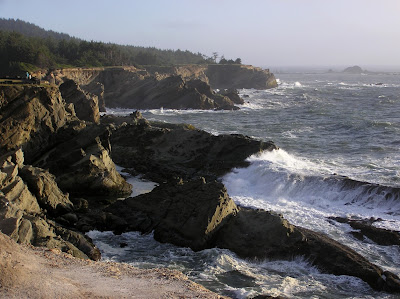My family sent me some birthday money. A camera I've long wanted to buy was on sale ... so, thank you! I bought it!
Though criticized for its fuzzy images and halation, the camera comes with a 30x optical zoom, image stabilization, and a digital zoom that only crops some of the image instead of magnifying and interpolating. What I'm saying here is that it's like a telescope.
Last weekend was Cyndi's birthday, and we returned to the wonderful campsite we visited nearly a year ago, a little lake in the mountains at the edge of a burned area. Swimming, hiking, and birding fun was had by all (Cyndi's daughter, Emily, joined us.) OK, I swam and the others were not quite as willing to trust the waters. But we all hiked and birded.
More on that later. For now, I just want to share an example photo from the previous camera I've been using; and my new camera, to show how it magnifies distant objects. I had to ask for help to make these images. One person looked through my spotting scope and called out the bird's position relative to large landmarks, and told me if it dove underwater or not, while I tried my best to aim and shoot. "To the right of the dock," or, "By the dead tree," or, "In front of the cattails," my assistant would say ... and I'd take a photo of some water, and sometimes, the birds.
This was the first time I'd seen a Red-necked Grebe, a Life Bird! Can you see the pair of them there? That's what my old camera shows. One can't tell if they're loons, ducks, grebes, or what.
 But, with the new camera ... hey, red necks and white faces; even a hint of a yellowish bill.
But, with the new camera ... hey, red necks and white faces; even a hint of a yellowish bill.
 And, with Emily looking through the scope, proclaiming excitedly, "They're fighting or something!" I took this photo of some natural greeting behaviour on the far side of the lake.
And, with Emily looking through the scope, proclaiming excitedly, "They're fighting or something!" I took this photo of some natural greeting behaviour on the far side of the lake.
 So, considering that these birds could not even be seen with the naked eye, I'm satisfied with my birthday present. Thanks family, you're the best!
So, considering that these birds could not even be seen with the naked eye, I'm satisfied with my birthday present. Thanks family, you're the best!
 This Black Phoebe was foraging for insects.
This Black Phoebe was foraging for insects. Here's the view of a sandy beach from high on the rocky headland. It looks like there may be a cave on the south side.
Here's the view of a sandy beach from high on the rocky headland. It looks like there may be a cave on the south side. Here's a close view of that rock jutting into the sea at such an angle.
Here's a close view of that rock jutting into the sea at such an angle. It almost seemed like there was a basalt layer in there, as I was reminded of the pillow lava from the edge of the sea in Hawaii.
It almost seemed like there was a basalt layer in there, as I was reminded of the pillow lava from the edge of the sea in Hawaii.  The waves were crashing in, creating that soothing rhythmic heartbeat, and the warm sun on a 70-degree day was a delightful relief from the hot summer back home in Idaho.
The waves were crashing in, creating that soothing rhythmic heartbeat, and the warm sun on a 70-degree day was a delightful relief from the hot summer back home in Idaho. My sister Jennifer explored the cave and proclaimed it went further into the darkness than the eye could see.
My sister Jennifer explored the cave and proclaimed it went further into the darkness than the eye could see. OK, this one is just a nice portrait of my best sister ever. (Thanks for driving over to the ocean to meet us and help celebrate my birthday, Jennifer!)
OK, this one is just a nice portrait of my best sister ever. (Thanks for driving over to the ocean to meet us and help celebrate my birthday, Jennifer!)










































